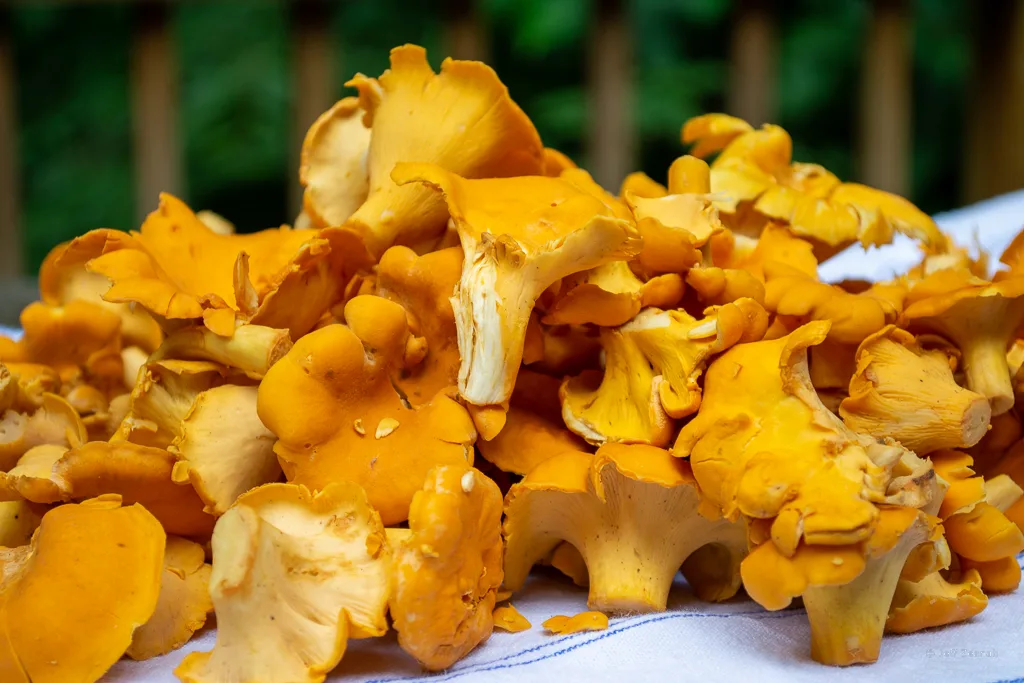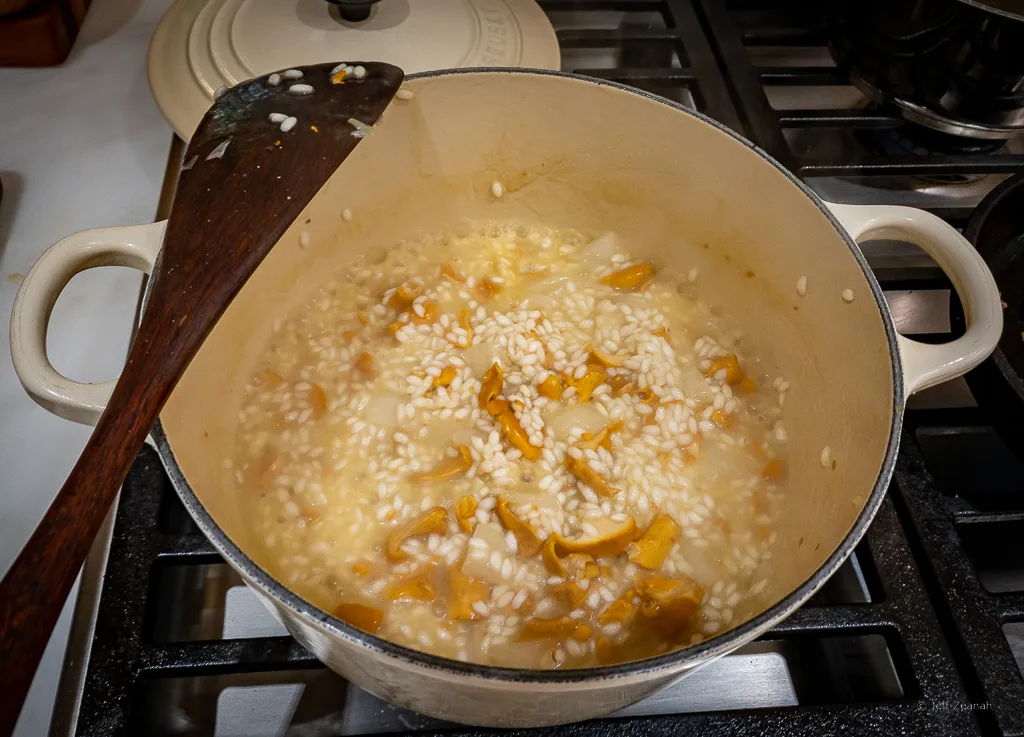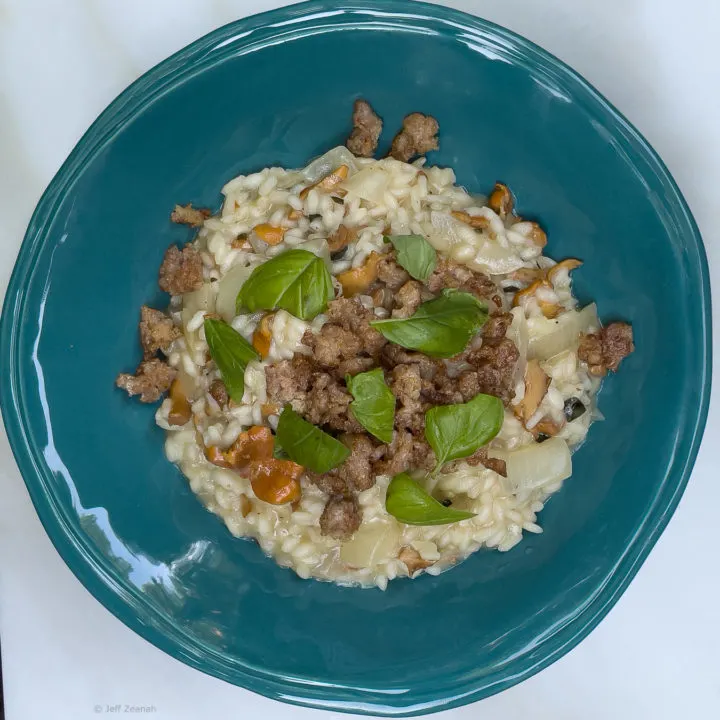Chanterelle mushrooms are perfect for risotto. In Italy, they are available in late summer and Chanterelle risotto, Risotto al Finerli in Italian, is a popular seasonal and regional version of mushroom risotto. They grow wild in much of the United States. In the South, they can be found in early to mid-summer, in the Northwest, in the fall. Not to mention frequently found in markets.

Chanterelles are easy to identify. However, if you are unfamiliar with hunting for them, it is best to first get some guidance from a local expert. Otherwise, they are available in markets and grocery stores.

They have a distinct flavor but also are good at absorbing flavors when cooked. Again, perfect for risotto. Additionally, they are also rich in minerals and vitamins. In this recipe, the risotto is topped with crumbled fresh sausage that is cooked alongside the risotto.
Risotto is an art form
Making a good risotto requires technique and time. It is an art form that should not be rushed, requiring many steps and almost constant stirring. One should not undertake this lightly. If you follow the art form and do not rush the cooking, it produces a much more flavorful creamy result. You may find the required repeated ladling of stock and stirring has a meditative quality about it.
The Chanterelle Risotto recipe below contains details of the classical technique, with modifications to give a creamier finished risotto.
Notes on Ingredients
Stock
To fully appreciate the flavor of the chanterelles, I prefer a lighter stock. A vegetable stock like my market stock, or chicken stock works best. If you feel your stock is too intense, water it down. There will be enough other flavors in this dish. If using the vegetable stock, I take an additional step of adding a bit of Parmesan rind to the stock while it simmers to fully give the dish the Parmesan flavor.
Italian Sausage
This dish may be made vegetarian, but is best with a topping of Italian Sausage. Fresh Italian sausage is required. It will be crumbled and browned and added on top. The spiciness is a matter of taste, but a mild or medium will allow for the chanterelles to shine.
Rice
Risotto requires special Italian rice. Arborio is the most commonly found outside of Italy, but many passionate Italian cooks swear by Carnaroli, and in the Veneto region the preference is Vialone Nano. I have found it produces a creamier texture.
Notes on Techniques
The below contains some important modifications to the classical technique I picked up from a detailed discussion on preparing risotto by Italian writer Massimo D’Almo. Please read the comments below (translated into English) about cooking the rice and the onions and the concept of “the wave”.
Wooden Spoon
A good risotto requires a lot of stirring. I suggest at least 30 minutes of almost constant stirring. I find that using a wooden spoon gives a quiet, relaxing feel to the effort. Wooden may be best, but frankly anything but metal. You do not want to listen to metal on metal scrapping for 30 minutes

Sautéing The Onions and Toasting the Rice
Almost every recipe for risotto and even the classical technique has a flaw in it that will drive you to toss your wooden spoon in frustration. The first step of risotto is to add butter and olive oil along with the onions and garlic to the pot and cook slowly until soft and golden brown. Then, you add the rice to toast it a bit. The toasting requires a higher temperature. As a result, you end up burning your onions, negating the care you put into the garlic and onions.
Overcooking the onions seems like a small issue, but the more you cook risotto, the more it bothers you. Therefore, I will discuss it in detail here. D’Almo suggests cooking the onions and garlic separately. Then after cooking, remove them from the pot and set them aside. Then toast the rice before adding the onion and garlic back into the risotto. After trying this approach, I find that it is the way to approach this. (If you want to avoid throwing your spoon).
Finishing with “The Wave”
D’Almo provides a perfect technique for finishing a dish. And the perfect metaphor for explaining it. The last of the stock needs to be absorbed and you want to finish with a creamy, uniform texture on top and throughout the dish. He calls this the wave. The technique involves turning the risotto by lifting the bottom of the rice and rolling on top, like a wave coming to shore. The sensation of seeing the creamy finish on top is a satisfying finish to your labors.

Chanterelle Risotto
Chanterelle risotto should be a famous dish
Ingredients
- 6 cups light vegetable or chicken stock
- A chunk of Parmesan rind, about 2 inches square (optional)
- 2 fresh Italian sausages (optional)
- 4 Tablespoons of butter
- 3 tablespoons of olive oil
- 2 cloves garlic, minced
- 1 medium onion, chopped
- 2 cups risotto rice (arborio, carnaroli, vialone nano, etc.)
- 12 ounces (320g) Chanterelle Mushrooms, chopped
- ½ glass dry white wine
- 2 tablespoons chopped fresh oregano or thyme
- 3 ounces (90g) grated Parmesan
- Chopped fresh parsley
- Salt and pepper, to taste
Instructions
To make this risotto will require three pans. The stock will be warmed in one pan. The risotto in another. The third pan will cook the sausage. The sausage may be cooked in advance. However, if you are up to juggling multiple pans, it can be cooked during the ample time the risotto simmers.
- Bring the stock along with the Parmesan rind to a gentle simmer in a pan. You will need to keep it on a low simmer as you work. Taste the stock before you begin to determine the level of saltiness.
- If using fresh sausage, remove the casing to prepare for cooking.
- Add about half of the tablespoon of the butter and olive oil to a medium pot big enough for the risotto along with the onions and garlic. Cook on low to medium heat until golden. Remove the onions and garlic from heat and set aside leaving the oils in the pan.
- Heat the remaining butter and olive oil in the pot on medium heat. Add the rice and toast for 2 or 3 minutes until it becomes slightly translucent.
- Add the chopped chanterelles and cook for a minute or so to soften and absorb some of the fats.
- Add the wine and the onion/garlic mix to the risotto pot along with any fat and juices in the saute pan. The wine should simmer quite rapidly. Stir constantly to prevent the rice from sticking and to allow the wine to be absorbed evenly.
- When the wine is absorbed, ladle about ⅓ cup (80 ml) of stock into the pot. Add salt, as needed. Adjust the heat to a light simmer, stirring frequently. When the liquid is almost completely absorbed, ladle in more. Add a little salt each time you ladle, if needed. How much depends on your salt taste in step 1. You will continue this process for about the next 20-30 minutes. Frequently stir making sure rice does not stick to the bottom and liquid is absorbed evenly.
- When you have the process of ladling and stirring well underway and under control, now you can start browning the sausage. In a separate pan crumble up the sausage into bits while browning. Since you are cooking slowly, you should be able to handle both jobs.
- When about half of the stock is in the risotto stir in the fresh oregano or thyme. When about ½ cup (120ml) of stock remains to be added start adding some of the grated Parmesan, reserving some for serving at the table. Grind some black pepper into the risotto. At this point, tasting is required to determine the quantities of Parmesan, salt, and pepper needed.
- When the last ladle of stock has been added, work carefully to continue to stir. When almost all of the liquid has been absorbed, remove it from heat and finish by turning the risotto by lifting it from the bottom and over the top almost like a wave. Dry sections will turn over wet sections creating a final perfect texture.
- Serve by mounding on a plate, top with the crumbled sausage, and some fresh parsley, and serve with the remaining grated parmesan at the table.
Nutrition Information:
Yield: 4 Serving Size: 1Amount Per Serving: Calories: 596Total Fat: 28gSaturated Fat: 14gTrans Fat: 1gUnsaturated Fat: 14gCholesterol: 58mgSodium: 689mgCarbohydrates: 53gFiber: 8gSugar: 9gProtein: 17g
Calculated Nutrition is estimated.

